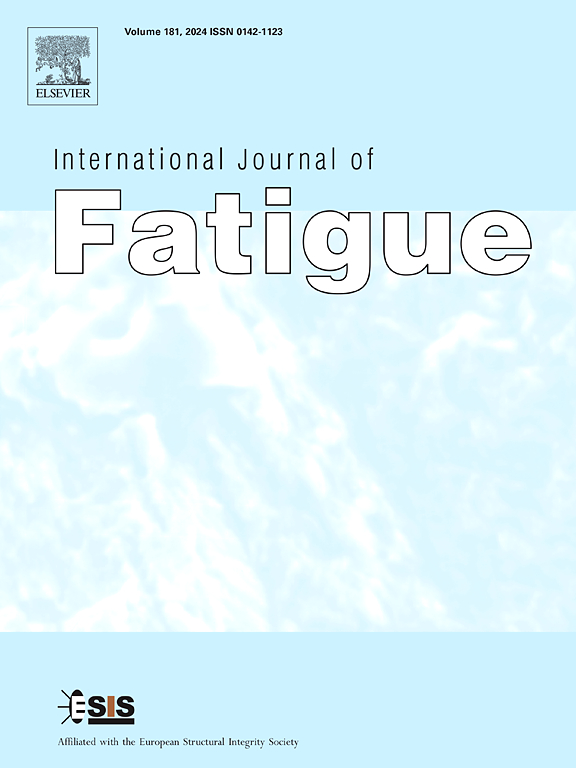复合材料层合板声发射疲劳损伤演化方程及寿命预测
IF 5.7
2区 材料科学
Q1 ENGINEERING, MECHANICAL
引用次数: 0
摘要
传统的声发射(AE)通常依靠机器学习或基于阈值的方法来建立信号与损坏之间的相关性。这些方法要么缺乏定量的严谨性,要么依赖于可解释性有限的黑箱模型。为了解决这些局限性,本研究利用 AE 信号开发了一个物理信息损伤演变方程,捕捉了制约复合材料层压板疲劳损伤的基本物理机制。通过将 AE 信号分析与现象学框架相结合,所提出的模型可从 AE 数据中提取损伤状态,并结合特定材料的物理参数,从而准确描述损伤发展过程并预测疲劳寿命。这种方法利用 AE 累积能量表征疲劳损伤演变,有效地重建了疲劳的三个关键阶段:初级损伤、稳态损伤和加速损伤。我们利用平织玻璃纤维/氰酸酯复合材料层压板(GFRP)和带开孔的多向对称碳纤维 CCF800H/AC531 层压板(CFRP)的 AE 数据进行了验证。结果表明,GFRP 和 CFRP 的预测疲劳寿命分别在各自误差带的 2 倍和 2.5 倍以内。这些发现强调了这种基于物理引导的 AE 方法在结构健康监测和复合材料疲劳寿命预测方面的应用潜力。本文章由计算机程序翻译,如有差异,请以英文原文为准。
Acoustic emission-driven fatigue damage evolution equation and life prediction of composite laminates
Conventional acoustic emission (AE) establishes correlations between signals and damage, often relying on machine learning or threshold-based approaches. These methods either lack quantitative rigor or depend on black-box models with limited interpretability. To address these limitations, this study leverages AE signals to develop a physics-informed damage evolution equation, capturing the underlying physical mechanisms governing fatigue damage in composite laminates. By integrating AE signal analysis with a phenomenological framework, the proposed model extracts damage state from AE data and incorporates material-specific physical parameters to accurately describe damage progression and predict fatigue life. This approach characterizes the fatigue damage evolution using AE cumulative energy, effectively reconstructing the three critical stages of fatigue: primary damage, steady-state damage, and accelerated damage. AE data from plain-woven glass fiber/cyanate composite laminate (GFRP) and multidirectional symmetric carbon fiber CCF800H/AC531 laminates (CFRP) with open-hole subjected to tension–tension loading were utilized for validation. The results showed that the predicted fatigue life for GFRP and CFRP falls within 2 and 2.5 times their respective error bands. These findings underscore the potential of this physics-guided AE-based methodology for applications in structural health monitoring and fatigue life prediction of composite materials.
求助全文
通过发布文献求助,成功后即可免费获取论文全文。
去求助
来源期刊

International Journal of Fatigue
工程技术-材料科学:综合
CiteScore
10.70
自引率
21.70%
发文量
619
审稿时长
58 days
期刊介绍:
Typical subjects discussed in International Journal of Fatigue address:
Novel fatigue testing and characterization methods (new kinds of fatigue tests, critical evaluation of existing methods, in situ measurement of fatigue degradation, non-contact field measurements)
Multiaxial fatigue and complex loading effects of materials and structures, exploring state-of-the-art concepts in degradation under cyclic loading
Fatigue in the very high cycle regime, including failure mode transitions from surface to subsurface, effects of surface treatment, processing, and loading conditions
Modeling (including degradation processes and related driving forces, multiscale/multi-resolution methods, computational hierarchical and concurrent methods for coupled component and material responses, novel methods for notch root analysis, fracture mechanics, damage mechanics, crack growth kinetics, life prediction and durability, and prediction of stochastic fatigue behavior reflecting microstructure and service conditions)
Models for early stages of fatigue crack formation and growth that explicitly consider microstructure and relevant materials science aspects
Understanding the influence or manufacturing and processing route on fatigue degradation, and embedding this understanding in more predictive schemes for mitigation and design against fatigue
Prognosis and damage state awareness (including sensors, monitoring, methodology, interactive control, accelerated methods, data interpretation)
Applications of technologies associated with fatigue and their implications for structural integrity and reliability. This includes issues related to design, operation and maintenance, i.e., life cycle engineering
Smart materials and structures that can sense and mitigate fatigue degradation
Fatigue of devices and structures at small scales, including effects of process route and surfaces/interfaces.
 求助内容:
求助内容: 应助结果提醒方式:
应助结果提醒方式:


